 HOME: www.hiltonpond.org |
|||
|
RUFOUS HUMMINGBIRD |
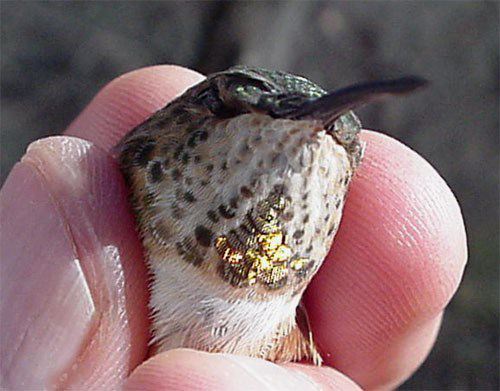
All text & photos © Hilton Pond Center We first got to know Don Hendershot in 1990 when we posted an Internet request for Native American hummingbird tales. Don is a reporter and nature writer for the weekly Smoky Mountain News; He also runs "A Walk on the Wild Side"--an ecotourism company based in Waynesville NC--and knew of several useful publications containing hummer myths. In the years since our original correspondence, we've exchanged e-mails about about such things as House Finch conjunctivitis-- and on 23 November he related a phone call he'd just received from Ann Kirby. 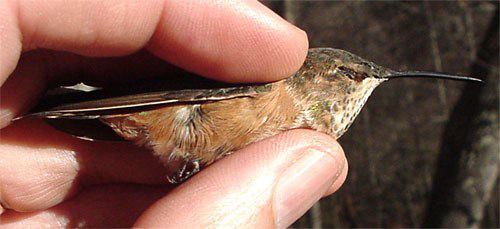 Ann--who is one of Don's many readers--knew of his nature interests and wanted him to know a hummingbird had been coming to her back porch feeder in Waynesville since about 1 November. (Waynesville is in Haywood County west of Asheville and not too far east of Great Smoky Mountains National Park.) With the cooperation of Ann and husband Ted, we arranged to meet up with Don at their home on 24 November 2002 to view the hummer and attempt its capture. 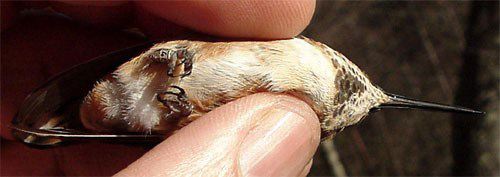 We departed Hilton Pond Center at 4:30 a.m. and got to the Kirby residence just before 7 a.m. with the hope of trapping the hummer during its first feeding foray of the day. There had been a hard freeze overnight, however, and the bird didn't rouse early. It finally appeared half an hour or so after sunrise--and then just for an instant as it took a quick look at our portable trap that now contained Ann's feeder. The bird made several more visits in the next hour, each time staying a second or two longer so that eventually we were able to see substantial rust on the bird's flanks and a central spot on its throat that was metallic red-orange.
Don volunteered that the bird appeared to be a Selasphorus hummer--either a Rufous or Allen's Hummingbird--and we agreed. In those species, only adult males have full iridescent gorgets, but young males of-the-year and females usually have one or more metallic throat feathers. Based on the apparent size of the bird and the extent of iridescence on its gorget, we suspected we were looking at an adult female and more likely a Rufous (S. rufus)--mostly because an Allen's (S. sasin) has never been reported from the Carolinas.
Thanks to Ann and Ted Kirby for hosting us and to Don Hendershot for serving as intermediary--and for promising a story about Waynesville's vagrant winter hummingbird in the next issue of Smoky Mountain News. Weight--3.6g Wing Chord--44.0mm Tail Length--26mm (5mm fork) Culmen (upper bill)--17mm All text & photos © Hilton Pond Center
If you're interested in sharing your hummingbird observations and learning from other enthusiasts, you may wish to subscribe to Hummingbird Hobnob, our Yahoo!-based discussion group. Also be sure to visit our award-winning Web site for Operation RubyThroat: The Hummingbird Project; on it you'll find almost anything you want to know about hummingbirds, including more information about Hummingbird Banding.
For much more information about hummingbirds, visit Operation RubyThroat: The Hummingbird Project |

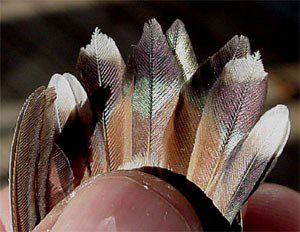 On its brief visits, the Waynesville hummer didn't seem too eager to dine, so we adjusted the trap to make the enclosed feeder easier to reach. Finally, at about 8:40 a.m.--just as Ann had prepared us some hot English tea--the bird entered the trap, sat on the feeder perch, and began lapping up sugar water. After a few seconds, we hit the remote trigger, the trapdoor fell shut, and soon we had the bird in hand for the banding process. Although the hummer did have plenty of rust on its sides, there wasn't much in the tail, so we still thought it was a female--a suspicion borne out by tail feather shape and a series of measurements that confirmed its sex and its species: female Rufous Hummingbird. An examination of the bill with a hand lens revealed it was completely smooth from tip to base--young birds have tiny etchings that eventually disappear as they age--so we were now positive the hummer was an "after hatch-year" bird that fledged sometime prior to 2002.
On its brief visits, the Waynesville hummer didn't seem too eager to dine, so we adjusted the trap to make the enclosed feeder easier to reach. Finally, at about 8:40 a.m.--just as Ann had prepared us some hot English tea--the bird entered the trap, sat on the feeder perch, and began lapping up sugar water. After a few seconds, we hit the remote trigger, the trapdoor fell shut, and soon we had the bird in hand for the banding process. Although the hummer did have plenty of rust on its sides, there wasn't much in the tail, so we still thought it was a female--a suspicion borne out by tail feather shape and a series of measurements that confirmed its sex and its species: female Rufous Hummingbird. An examination of the bill with a hand lens revealed it was completely smooth from tip to base--young birds have tiny etchings that eventually disappear as they age--so we were now positive the hummer was an "after hatch-year" bird that fledged sometime prior to 2002.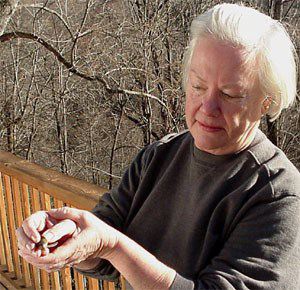 After banding the bird, we hand-held it for a long drink from the feeder and then documented it with the photographs on this page. In appreciation for her interest, we asked Ann to release the hummer (right), after which we returned to finally finish off that excellent cup of tea she had prepared earlier. Like hummingbirds, we take our beverage with sugar--but NOT in the super-sweet 4:1 ratio used in hummer feeders.
After banding the bird, we hand-held it for a long drink from the feeder and then documented it with the photographs on this page. In appreciation for her interest, we asked Ann to release the hummer (right), after which we returned to finally finish off that excellent cup of tea she had prepared earlier. Like hummingbirds, we take our beverage with sugar--but NOT in the super-sweet 4:1 ratio used in hummer feeders.
 Students at GLOBE-certified schools may submit winter hummingbird observations as part of Operation RubyThroat and GLOBE. Students can also correlate hummingbird observations with data on abiotic factors, including atmosphere, climate, hydrology, soils, land cover, and phenology. See the
Students at GLOBE-certified schools may submit winter hummingbird observations as part of Operation RubyThroat and GLOBE. Students can also correlate hummingbird observations with data on abiotic factors, including atmosphere, climate, hydrology, soils, land cover, and phenology. See the 



